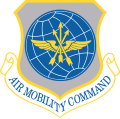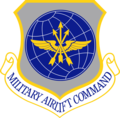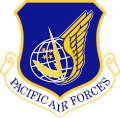457th Airlift Squadron  | |
|---|---|
 A squadron C-21 Learjet comes in for a landing at Scott AFB | |
| Active | 1942–1945; 1949–1951; 1966–1972; 1975–2019 |
| Country | |
| Branch | |
| Role | Airlift |
| Motto(s) | The Wings of Command [1] |
| Engagements | Pacific Ocean Theater Vietnam War [1] |
| Decorations | Distinguished Unit Citation Presidential Unit Citation Air Force Outstanding Unit Award with Combat "V" Device Air Force Outstanding Unit Award Republic of Vietnam Gallantry Cross with Palm [1] |
| Insignia | |
| 457th Airlift Squadron emblem [a] [1] |  |
| 457th Tactical Airlift Sq emblem [b] [1] |  |
| 457th Bombardment Squadron emblem [2] |  |
| Viet Nam tail code [3] | KA |
The 457th Airlift Squadron was an executive airlift unit stationed at Andrews Air Force Base, Maryland. It, and its predecessor, the 1402nd Military Airlift Squadron, operated a number of executive aircraft starting in 1975. From the mid-1990s, the squadron operated only Learjet C-21 aircraft.
Contents
- History
- World War II
- Air Force reserve
- Theater airlift in Viet Nam
- Executive airlift
- Lineage
- Assignments
- Components
- Stations
- Aircraft operated
- Awards and campaigns
- See also
- References
- Notes
- Bibliography
The squadron's other predecessor was organized in 1942 as the 457th Bombardment Squadron, a heavy bomber training unit. It was inactivated in the spring of 1944 when the Army Air Forces reorganized its training units on a more flexible basis. The squadron was immediately activated as a Boeing B-29 Superfortress unit. After training in the United States, it deployed to Guam, where it participated in the strategic bombing campaign against Japan, earning two Distinguished Unit Citations. Following V-J Day it remained on Guam until November 1945, when it was inactivated.
The squadron was activated as a corollary unit in the reserve in 1949, serving alongside regular Strategic Air Command units at March Air Force Base. It was mobilized as a result of the Korean War in 1951, but inactivated as its personnel were used to fully man other units. When the reserve began to re-equip with aircraft in 1952, it was briefly activated as the 457th Troop Carrier Squadron, but transferred its personnel and equipment to another unit a month later.
It was organized again in 1967 when the Air Force took over de Havilland Canada C-7 Caribou operations from the Army. It performed theater airlift missions in Viet Nam until inactivating in 1972 as the United States withdrew from Viet Nam. It earned both Presidential Unit Citations and Air Force Outstanding Unit Awards with Combat "V" Device for its combat actions.









